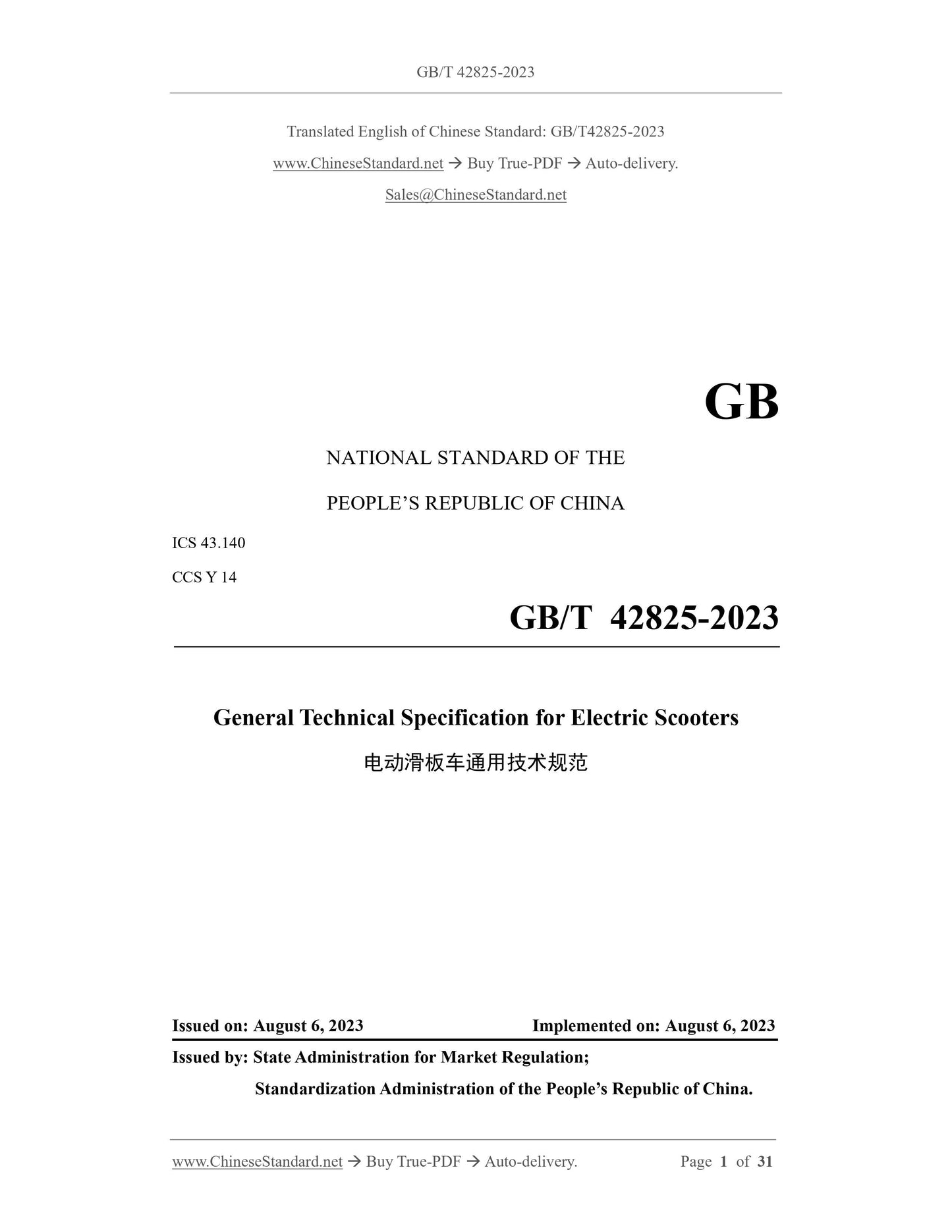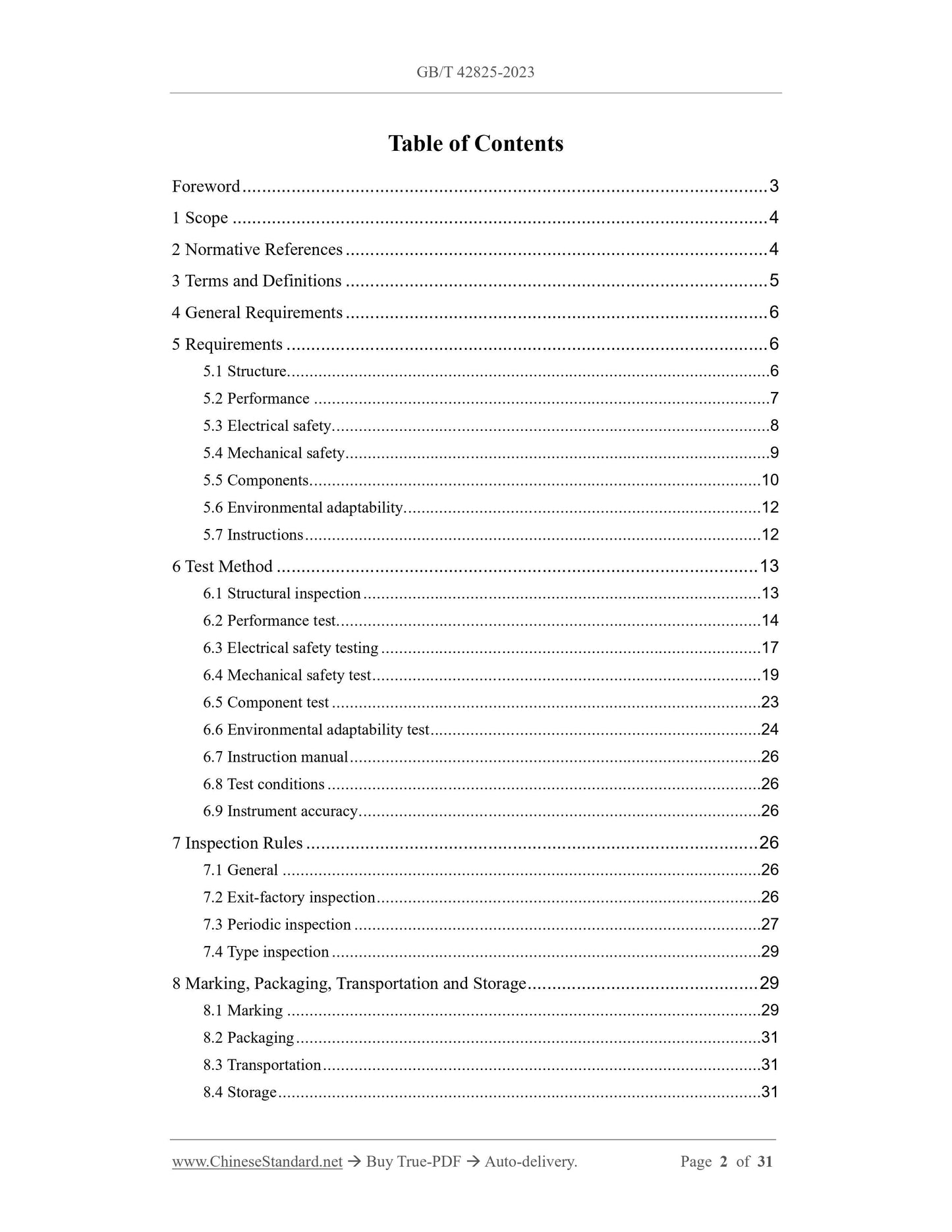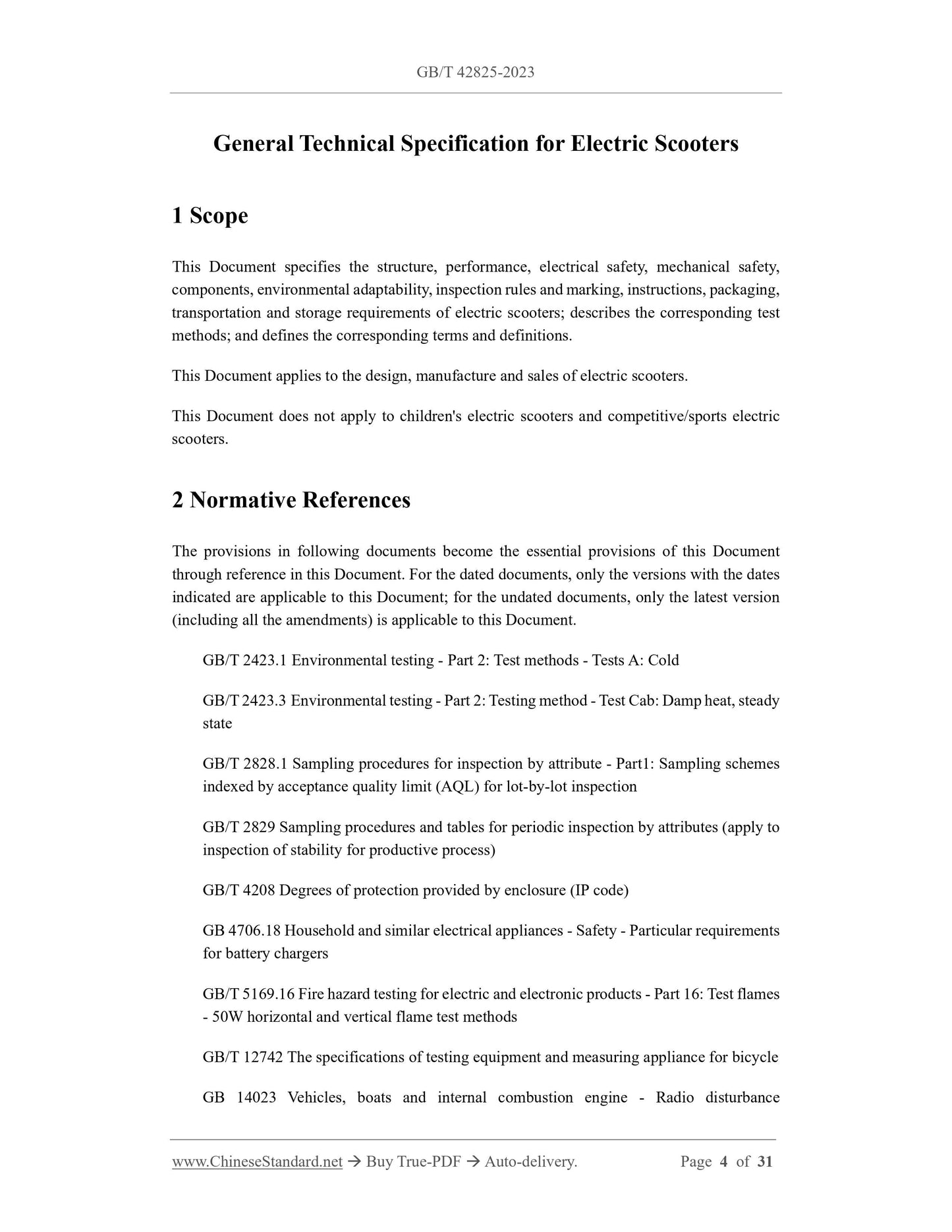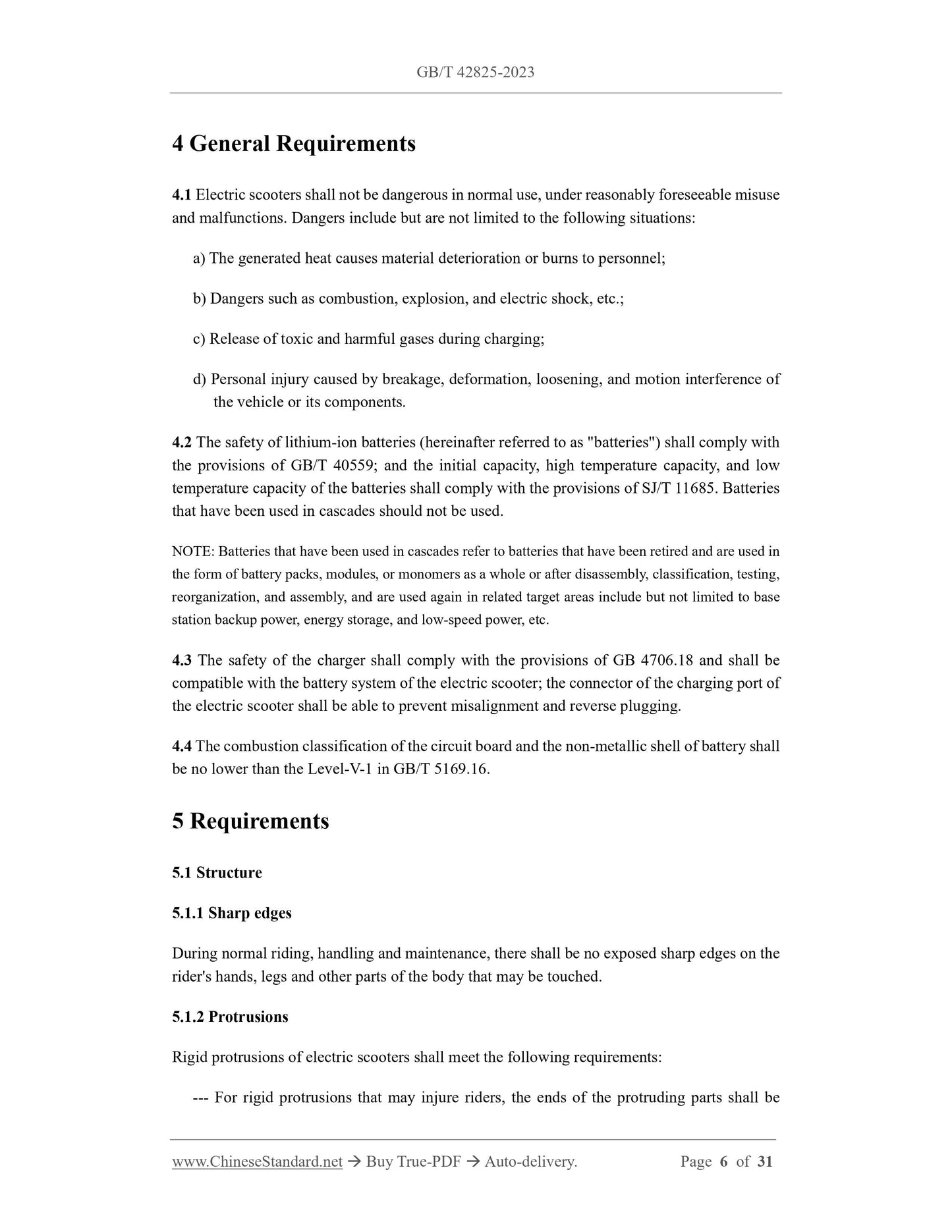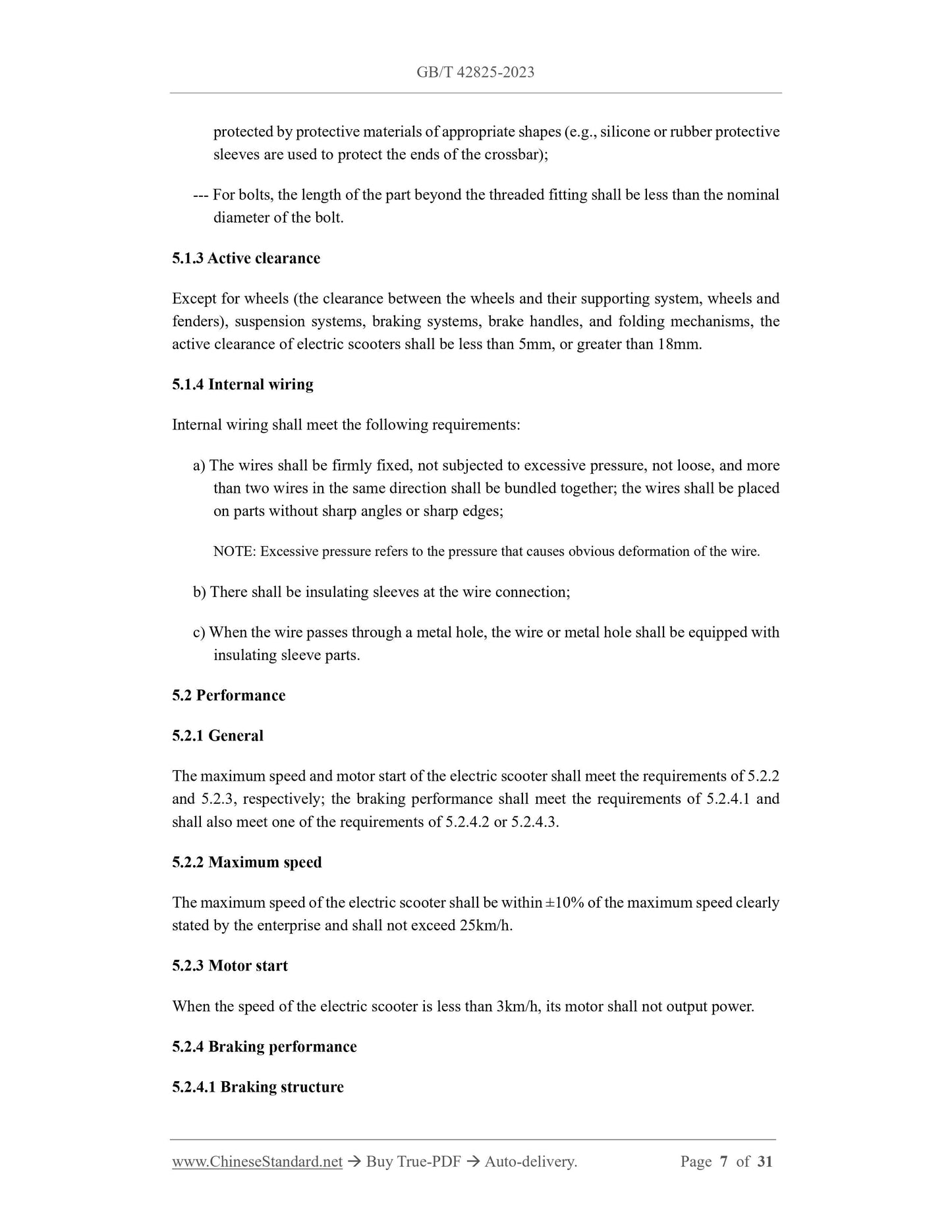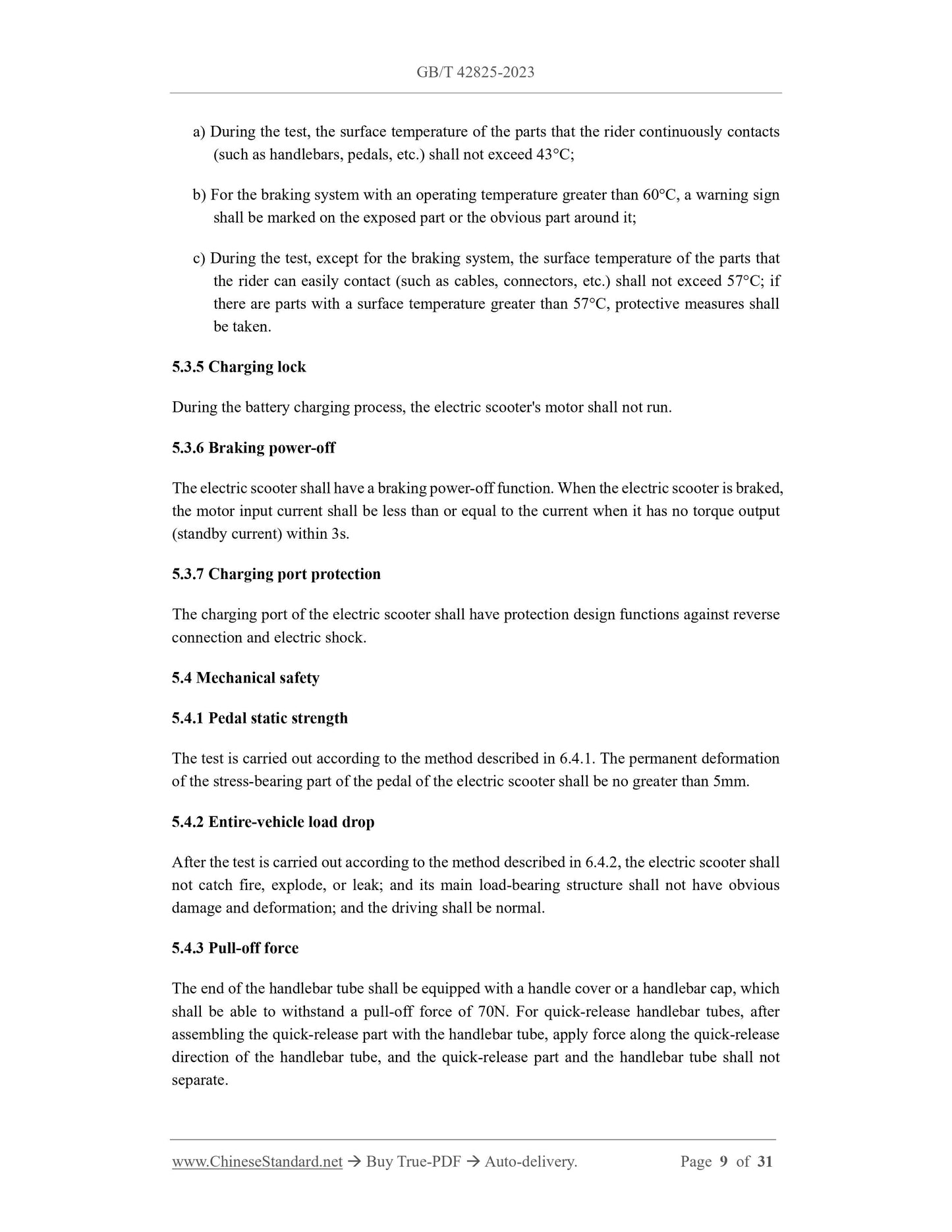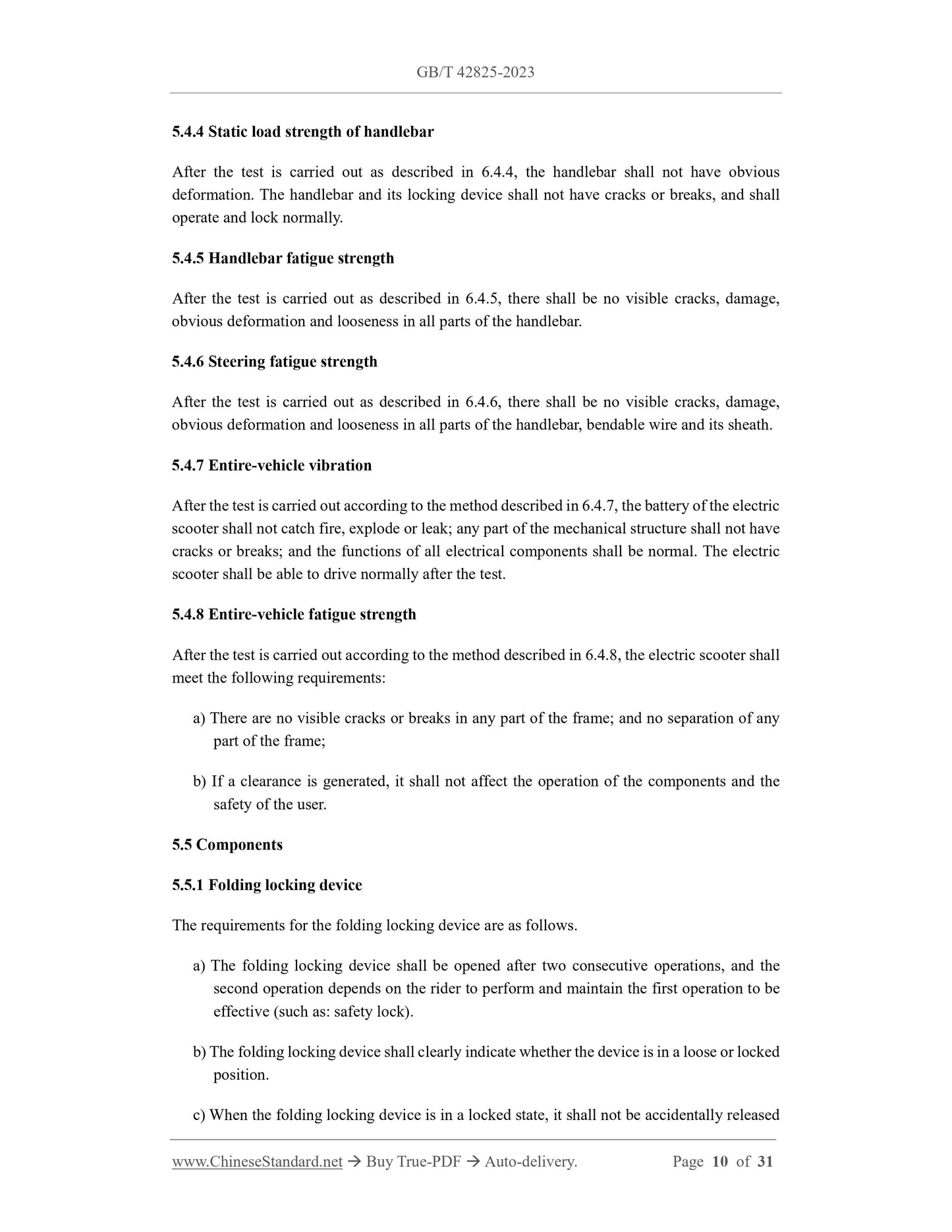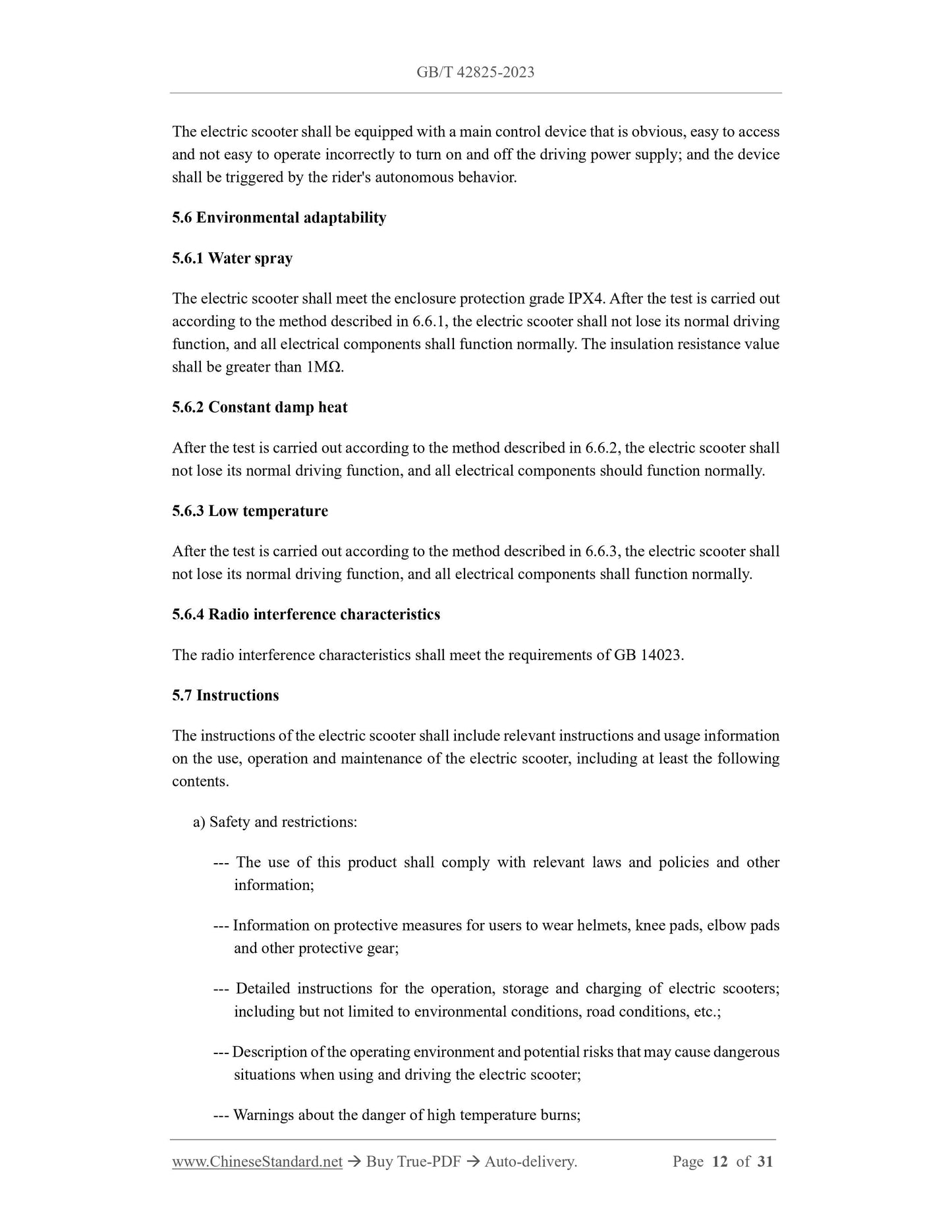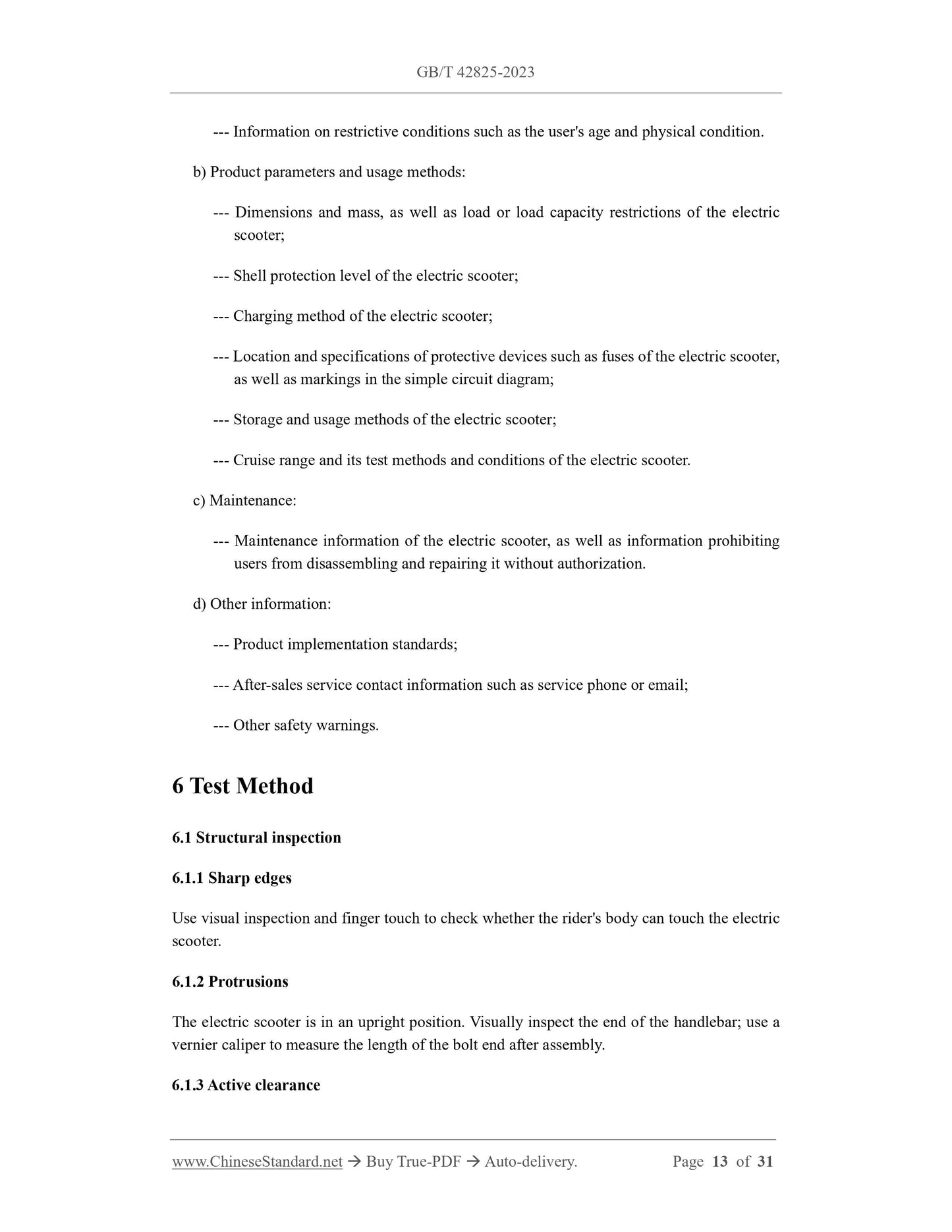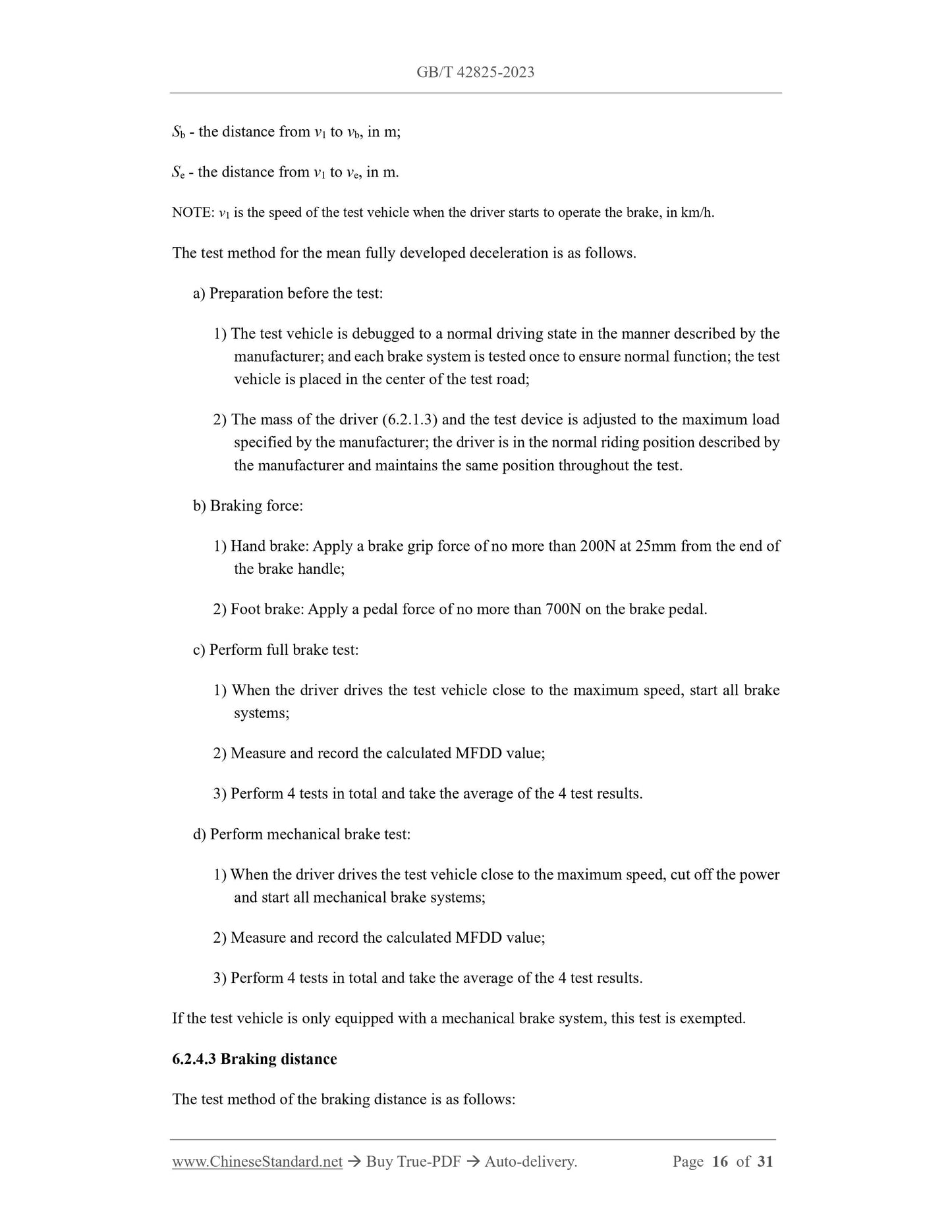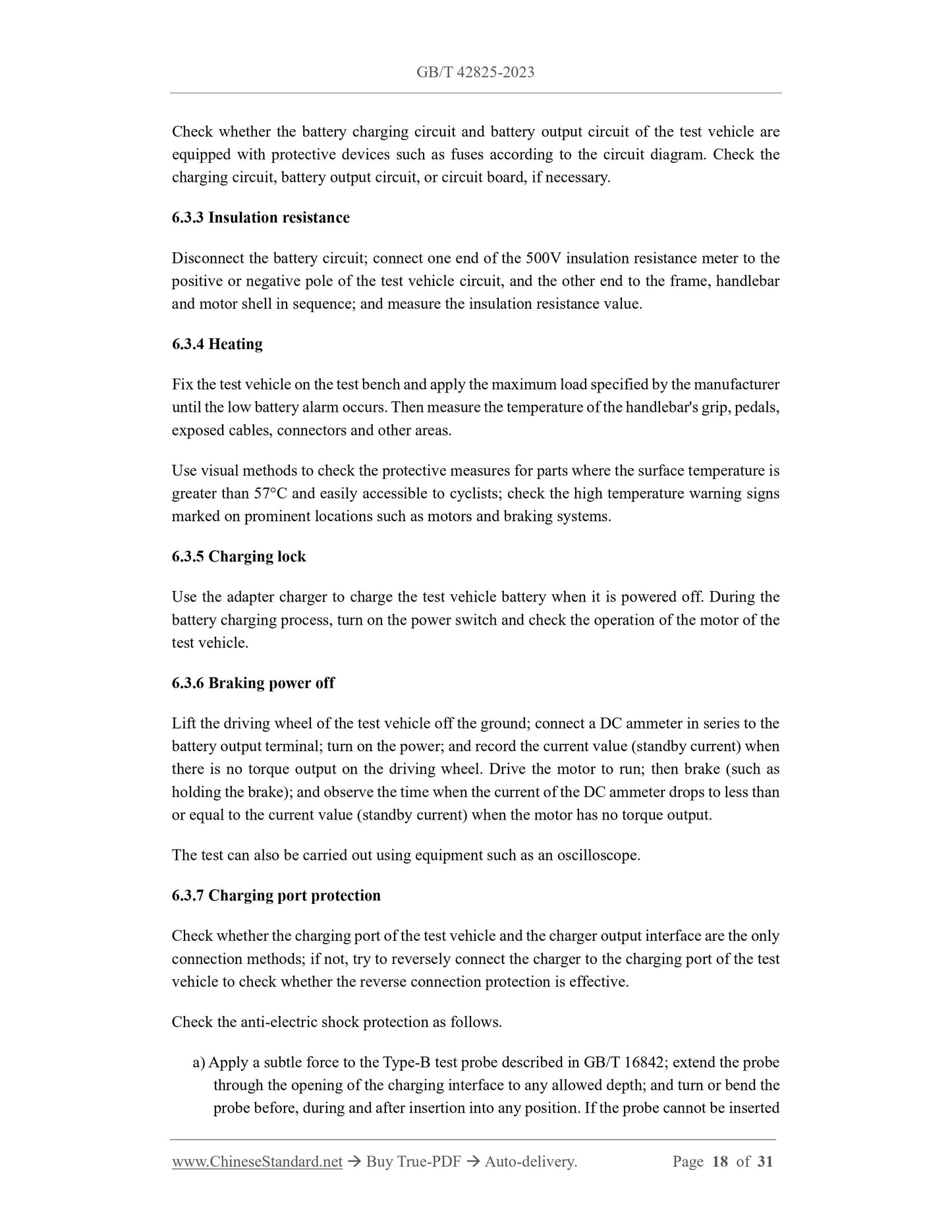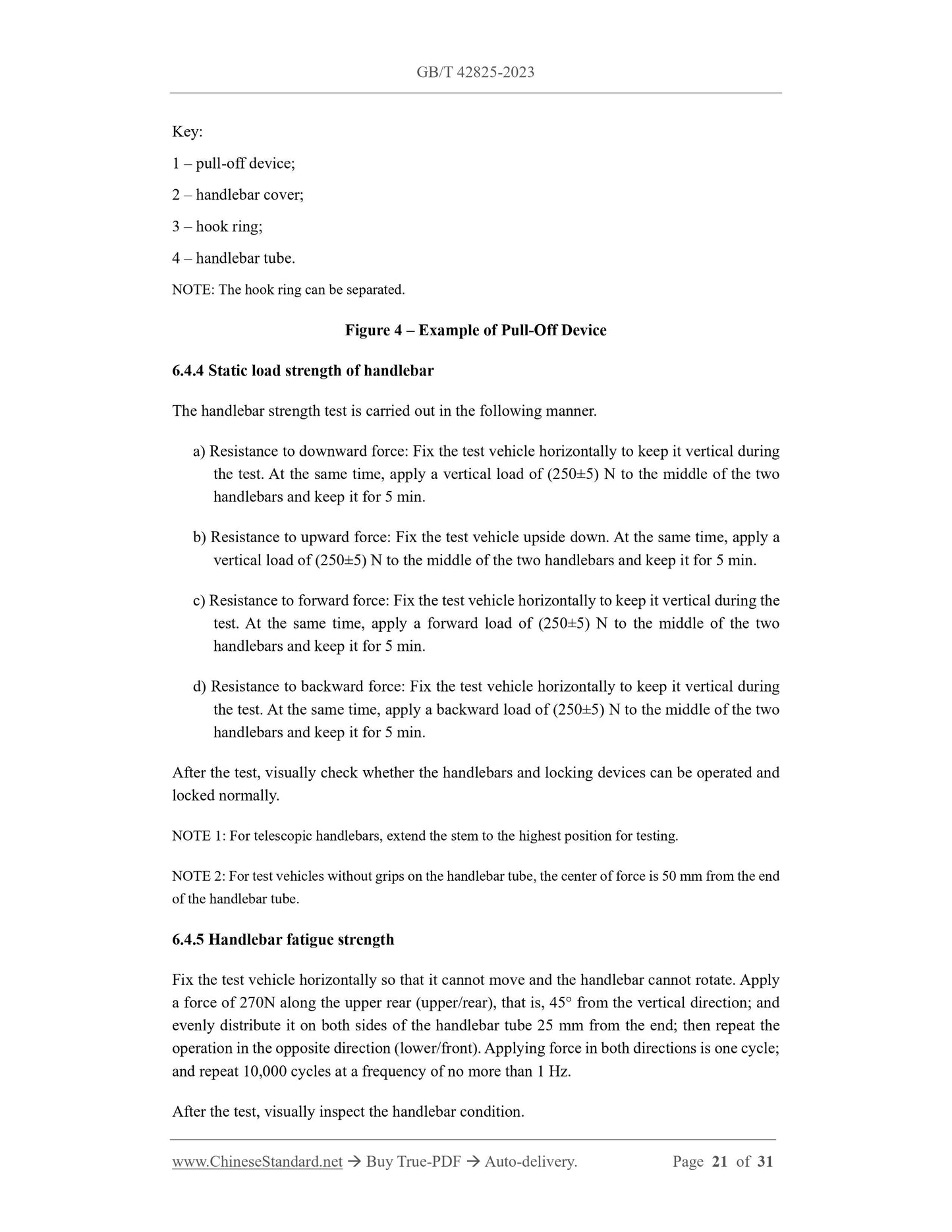1
/
of
12
PayPal, credit cards. Download editable-PDF and invoice in 1 second!
GB/T 42825-2023 English PDF (GBT42825-2023)
GB/T 42825-2023 English PDF (GBT42825-2023)
Regular price
$480.00 USD
Regular price
Sale price
$480.00 USD
Unit price
/
per
Shipping calculated at checkout.
Couldn't load pickup availability
Delivery: 3 seconds. Download true-PDF + Invoice.
Get QUOTATION in 1-minute: Click GB/T 42825-2023
Historical versions: GB/T 42825-2023
Preview True-PDF (Reload/Scroll if blank)
GB/T 42825-2023: General technical specification for electric scooters
GB/T 42825-2023
GB
NATIONAL STANDARD OF THE
PEOPLE’S REPUBLIC OF CHINA
ICS 43.140
CCS Y 14
General Technical Specification for Electric Scooters
ISSUED ON: AUGUST 6, 2023
IMPLEMENTED ON: AUGUST 6, 2023
Issued by: State Administration for Market Regulation;
Standardization Administration of the People’s Republic of China.
Table of Contents
Foreword ... 3
1 Scope ... 4
2 Normative References ... 4
3 Terms and Definitions ... 5
4 General Requirements ... 6
5 Requirements ... 6
5.1 Structure ... 6
5.2 Performance ... 7
5.3 Electrical safety... 8
5.4 Mechanical safety... 9
5.5 Components ... 10
5.6 Environmental adaptability ... 12
5.7 Instructions ... 12
6 Test Method ... 13
6.1 Structural inspection ... 13
6.2 Performance test... 14
6.3 Electrical safety testing ... 17
6.4 Mechanical safety test ... 19
6.5 Component test ... 23
6.6 Environmental adaptability test ... 24
6.7 Instruction manual ... 26
6.8 Test conditions ... 26
6.9 Instrument accuracy ... 26
7 Inspection Rules ... 26
7.1 General ... 26
7.2 Exit-factory inspection ... 26
7.3 Periodic inspection ... 27
7.4 Type inspection ... 29
8 Marking, Packaging, Transportation and Storage ... 29
8.1 Marking ... 29
8.2 Packaging ... 31
8.3 Transportation ... 31
8.4 Storage ... 31
General Technical Specification for Electric Scooters
1 Scope
This Document specifies the structure, performance, electrical safety, mechanical safety,
components, environmental adaptability, inspection rules and marking, instructions, packaging,
transportation and storage requirements of electric scooters; describes the corresponding test
methods; and defines the corresponding terms and definitions.
This Document applies to the design, manufacture and sales of electric scooters.
This Document does not apply to children's electric scooters and competitive/sports electric
scooters.
2 Normative References
The provisions in following documents become the essential provisions of this Document
through reference in this Document. For the dated documents, only the versions with the dates
indicated are applicable to this Document; for the undated documents, only the latest version
(including all the amendments) is applicable to this Document.
GB/T 2423.1 Environmental testing - Part 2: Test methods - Tests A: Cold
GB/T 2423.3 Environmental testing - Part 2: Testing method - Test Cab: Damp heat, steady
state
GB/T 2828.1 Sampling procedures for inspection by attribute - Part1: Sampling schemes
indexed by acceptance quality limit (AQL) for lot-by-lot inspection
GB/T 2829 Sampling procedures and tables for periodic inspection by attributes (apply to
inspection of stability for productive process)
GB/T 4208 Degrees of protection provided by enclosure (IP code)
GB 4706.18 Household and similar electrical appliances - Safety - Particular requirements
for battery chargers
GB/T 5169.16 Fire hazard testing for electric and electronic products - Part 16: Test flames
- 50W horizontal and vertical flame test methods
GB/T 12742 The specifications of testing equipment and measuring appliance for bicycle
GB 14023 Vehicles, boats and internal combustion engine - Radio disturbance
4 General Requirements
4.1 Electric scooters shall not be dangerous in normal use, under reasonably foreseeable misuse
and malfunctions. Dangers include but are not limited to the following situations:
a) The generated heat causes material deterioration or burns to personnel;
b) Dangers such as combustion, explosion, and electric shock, etc.;
c) Release of toxic and harmful gases during charging;
d) Personal injury caused by breakage, deformation, loosening, and motion interference of
the vehicle or its components.
4.2 The safety of lithium-ion batteries (hereinafter referred to as "batteries") shall comply with
the provisions of GB/T 40559; and the initial capacity, high temperature capacity, and low
temperature capacity of the batteries shall comply with the provisions of SJ/T 11685. Batteries
that have been used in cascades should not be used.
NOTE: Batteries that have been used in cascades refer to batteries that have been retired and are used in
the form of battery packs, modules, or monomers as a whole or after disassembly, classification, testing,
reorganization, and assembly, and are used again in related target areas include but not limited to base
station backup power, energy storage, and low-speed power, etc.
4.3 The safety of the charger shall comply with the provisions of GB 4706.18 and shall be
compatible with the battery system of the electric scooter; the connector of the charging port of
the electric scooter shall be able to prevent misalignment and reverse plugging.
4.4 The combustion classification of the circuit board and the non-metallic shell of battery shall
be no lower than the Level-V-1 in GB/T 5169.16.
5 Requirements
5.1 Structure
5.1.1 Sharp edges
During normal riding, handling and maintenance, there shall be no exposed sharp edges on the
rider's hands, legs and other parts of the body that may be touched.
5.1.2 Protrusions
Rigid protrusions of electric scooters shall meet the following requirements:
--- For rigid protrusions that may injure riders, the ends of the protruding parts shall be
protected by protective materials of appropriate shapes (e.g., silicone or rubber protective
sleeves are used to protect the ends of the crossbar);
--- For bolts, the length of the part beyond the threaded fitting shall be less than the nominal
diameter of the bolt.
5.1.3 Active clearance
Except for wheels (the clearance between the wheels and their supporting system, wheels and
fenders), suspension systems, braking systems, brake handles, and folding mechanisms, the
active clearance of electric scooters shall be less than 5mm, or greater than 18mm.
5.1.4 Internal wiring
Internal wiring shall meet the following requirements:
a) The wires shall be firmly fixed, not subjected to excessive pressure, not loose, and more
than two wires in the same direction shall be bundled together; the wires shall be placed
on parts without sharp angles or sharp edges;
NOTE: Excessive pressure refers to the pressure that causes obvious deformation of the wire.
b) There shall be insulating sleeves at the wire connection;
c) When the wire passes through a metal hole, the wire or metal hole shall be equipped with
insulating sleeve parts.
5.2 Performance
5.2.1 General
The maximum speed and motor start of the electric scooter shall meet the requirements of 5.2.2
and 5.2.3, respectively; the braking performance shall meet the requirements of 5.2.4.1 and
shall also meet one of the requirements of 5.2.4.2 or 5.2.4.3.
5.2.2 Maximum speed
The maximum speed of the electric scooter shall be within ±10% of the maximum speed clearly
stated by the enterprise and shall not exceed 25km/h.
5.2.3 Motor start
When the speed of the electric scooter is less than 3km/h, its motor shall not output power.
5.2.4 Braking performance
5.2.4.1 Braking structure
a) During the test, the surface temperature of the parts that the rider continuously contacts
(such as handlebars, pedals, etc.) shall not exceed 43°C;
b) For the braking system with an operating temperature greater than 60°C, a warning sign
shall be marked on the exposed part or the obvious part around it;
c) During the test, except for the braking system, the surface temperature of the part...
Get QUOTATION in 1-minute: Click GB/T 42825-2023
Historical versions: GB/T 42825-2023
Preview True-PDF (Reload/Scroll if blank)
GB/T 42825-2023: General technical specification for electric scooters
GB/T 42825-2023
GB
NATIONAL STANDARD OF THE
PEOPLE’S REPUBLIC OF CHINA
ICS 43.140
CCS Y 14
General Technical Specification for Electric Scooters
ISSUED ON: AUGUST 6, 2023
IMPLEMENTED ON: AUGUST 6, 2023
Issued by: State Administration for Market Regulation;
Standardization Administration of the People’s Republic of China.
Table of Contents
Foreword ... 3
1 Scope ... 4
2 Normative References ... 4
3 Terms and Definitions ... 5
4 General Requirements ... 6
5 Requirements ... 6
5.1 Structure ... 6
5.2 Performance ... 7
5.3 Electrical safety... 8
5.4 Mechanical safety... 9
5.5 Components ... 10
5.6 Environmental adaptability ... 12
5.7 Instructions ... 12
6 Test Method ... 13
6.1 Structural inspection ... 13
6.2 Performance test... 14
6.3 Electrical safety testing ... 17
6.4 Mechanical safety test ... 19
6.5 Component test ... 23
6.6 Environmental adaptability test ... 24
6.7 Instruction manual ... 26
6.8 Test conditions ... 26
6.9 Instrument accuracy ... 26
7 Inspection Rules ... 26
7.1 General ... 26
7.2 Exit-factory inspection ... 26
7.3 Periodic inspection ... 27
7.4 Type inspection ... 29
8 Marking, Packaging, Transportation and Storage ... 29
8.1 Marking ... 29
8.2 Packaging ... 31
8.3 Transportation ... 31
8.4 Storage ... 31
General Technical Specification for Electric Scooters
1 Scope
This Document specifies the structure, performance, electrical safety, mechanical safety,
components, environmental adaptability, inspection rules and marking, instructions, packaging,
transportation and storage requirements of electric scooters; describes the corresponding test
methods; and defines the corresponding terms and definitions.
This Document applies to the design, manufacture and sales of electric scooters.
This Document does not apply to children's electric scooters and competitive/sports electric
scooters.
2 Normative References
The provisions in following documents become the essential provisions of this Document
through reference in this Document. For the dated documents, only the versions with the dates
indicated are applicable to this Document; for the undated documents, only the latest version
(including all the amendments) is applicable to this Document.
GB/T 2423.1 Environmental testing - Part 2: Test methods - Tests A: Cold
GB/T 2423.3 Environmental testing - Part 2: Testing method - Test Cab: Damp heat, steady
state
GB/T 2828.1 Sampling procedures for inspection by attribute - Part1: Sampling schemes
indexed by acceptance quality limit (AQL) for lot-by-lot inspection
GB/T 2829 Sampling procedures and tables for periodic inspection by attributes (apply to
inspection of stability for productive process)
GB/T 4208 Degrees of protection provided by enclosure (IP code)
GB 4706.18 Household and similar electrical appliances - Safety - Particular requirements
for battery chargers
GB/T 5169.16 Fire hazard testing for electric and electronic products - Part 16: Test flames
- 50W horizontal and vertical flame test methods
GB/T 12742 The specifications of testing equipment and measuring appliance for bicycle
GB 14023 Vehicles, boats and internal combustion engine - Radio disturbance
4 General Requirements
4.1 Electric scooters shall not be dangerous in normal use, under reasonably foreseeable misuse
and malfunctions. Dangers include but are not limited to the following situations:
a) The generated heat causes material deterioration or burns to personnel;
b) Dangers such as combustion, explosion, and electric shock, etc.;
c) Release of toxic and harmful gases during charging;
d) Personal injury caused by breakage, deformation, loosening, and motion interference of
the vehicle or its components.
4.2 The safety of lithium-ion batteries (hereinafter referred to as "batteries") shall comply with
the provisions of GB/T 40559; and the initial capacity, high temperature capacity, and low
temperature capacity of the batteries shall comply with the provisions of SJ/T 11685. Batteries
that have been used in cascades should not be used.
NOTE: Batteries that have been used in cascades refer to batteries that have been retired and are used in
the form of battery packs, modules, or monomers as a whole or after disassembly, classification, testing,
reorganization, and assembly, and are used again in related target areas include but not limited to base
station backup power, energy storage, and low-speed power, etc.
4.3 The safety of the charger shall comply with the provisions of GB 4706.18 and shall be
compatible with the battery system of the electric scooter; the connector of the charging port of
the electric scooter shall be able to prevent misalignment and reverse plugging.
4.4 The combustion classification of the circuit board and the non-metallic shell of battery shall
be no lower than the Level-V-1 in GB/T 5169.16.
5 Requirements
5.1 Structure
5.1.1 Sharp edges
During normal riding, handling and maintenance, there shall be no exposed sharp edges on the
rider's hands, legs and other parts of the body that may be touched.
5.1.2 Protrusions
Rigid protrusions of electric scooters shall meet the following requirements:
--- For rigid protrusions that may injure riders, the ends of the protruding parts shall be
protected by protective materials of appropriate shapes (e.g., silicone or rubber protective
sleeves are used to protect the ends of the crossbar);
--- For bolts, the length of the part beyond the threaded fitting shall be less than the nominal
diameter of the bolt.
5.1.3 Active clearance
Except for wheels (the clearance between the wheels and their supporting system, wheels and
fenders), suspension systems, braking systems, brake handles, and folding mechanisms, the
active clearance of electric scooters shall be less than 5mm, or greater than 18mm.
5.1.4 Internal wiring
Internal wiring shall meet the following requirements:
a) The wires shall be firmly fixed, not subjected to excessive pressure, not loose, and more
than two wires in the same direction shall be bundled together; the wires shall be placed
on parts without sharp angles or sharp edges;
NOTE: Excessive pressure refers to the pressure that causes obvious deformation of the wire.
b) There shall be insulating sleeves at the wire connection;
c) When the wire passes through a metal hole, the wire or metal hole shall be equipped with
insulating sleeve parts.
5.2 Performance
5.2.1 General
The maximum speed and motor start of the electric scooter shall meet the requirements of 5.2.2
and 5.2.3, respectively; the braking performance shall meet the requirements of 5.2.4.1 and
shall also meet one of the requirements of 5.2.4.2 or 5.2.4.3.
5.2.2 Maximum speed
The maximum speed of the electric scooter shall be within ±10% of the maximum speed clearly
stated by the enterprise and shall not exceed 25km/h.
5.2.3 Motor start
When the speed of the electric scooter is less than 3km/h, its motor shall not output power.
5.2.4 Braking performance
5.2.4.1 Braking structure
a) During the test, the surface temperature of the parts that the rider continuously contacts
(such as handlebars, pedals, etc.) shall not exceed 43°C;
b) For the braking system with an operating temperature greater than 60°C, a warning sign
shall be marked on the exposed part or the obvious part around it;
c) During the test, except for the braking system, the surface temperature of the part...
Share
